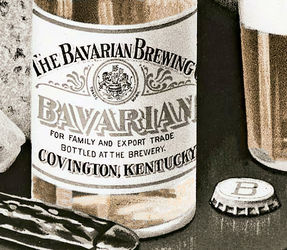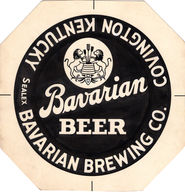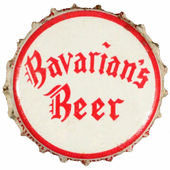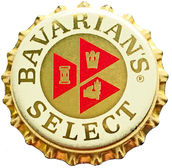
THE BEGINNINGS
- Of Bavarian Brewery
THE BEGINNINGS
- Of Bavarian Brewery
ADS - From Newspapers
CROWN CAPS a/k/a Bottle Caps
ABOUT CROWNS
(i.e. Bottle Caps)
What most people refer to as a bottle cap, is technically a "crown cap," or simply called a "crown" by Breweriana collectors. The crown was developed in 1892 by William Painter, from Baltimore. It was originally called a "crown cork," because it seemed to resemble the British crown and it was lined with cork. However, the lining of cork changed to a layer of composite cork several years before Prohibition. After Prohibition, beginning in the early 1930s, a thin layer of fluted metal, resembling metal foil, was laid on top of the composite cork. Beginning around 1960, crown liners began to have plastic surfaces. More recently, crowns are simply lined with a thin and transparent layer. (For examples, please view the bottom of this page.) The crown cap originally had 23 points; most today have 21 points. Relatively recently, some crowns are now being made with 29 points. An alternate term for points is flutes or corrugations. Crowns can be made with either metal or aluminum. This can be discerned by using a magnet, which will connect with metal, but not to aluminum.
Prior to the invention of the crown, a beer bottle often had a stopper that was secured by corks and later by a porcelain or hard stopper. These stoppers were secured by a wire bracket, called a Lightning or Swing Top. But even then, this did not always keep the top secure from an explosion from built in carbonation. However, the crown eliminated this problem and was readily adopted. An example of an early Bavarian bottle before the use of crowns with such a bracket, and a wooden case the bottles came in, are shown in Bottles and Cases. It appears Bavarian Brewery used crowns when or shortly after they opened a Bottling Department in 1892, which was rebuilt in 1908.
PRE-PROHIBTION CROWNS
Bavarian Beer c. 1910s. No bottle caps for any beers bottled by Bavarian Brewing Co. have yet been obtained before Prohibition. However, an image of what one likely looked like for Bavarian Beer, alongside a bottle of Bavarian Beer, is shown simply with a large B in a circle. Bavarian probably used other crowns for other beers as well as perhaps for their Ale and Porter. Please click on any image for a large picture and more information. Should anyone have Bavarian crowns Pre-Prohibition, as well as any others that are not displayed in this section and be willing to share images of them, please contact us.

CROWNS AFTER PROHIBITION
When the Bavarian Brewing Co. reopened after Prohibition in 1935, it appears they mostly if not exclusively supplied draft beer in barrels, and may have had limited bottle beer distribution, if any at all. However, Bavarian Beer was offered in bottles when the Schott Brothers began operating the brewery in 1938. At that time and for at a few years years later, the beer tax paid was shown on a neck label affixed to a bottle. (Please view Beer Labels.) Therefore, the bottle caps at that time simply indicated the name of the beer on the top of the crown and the name of the brewery and its location on the side of the cap.
Shown is the design or proof of one of the first bottle caps created for Bavarian Beer after Prohibition, along with an actual crown c. 1940. On the side of this crown was the name of the brewery and its location, as shown on the proof - sans "Sealex" - and no beer tax paid was shown.

Ohio and Kentucky Crowns For Bavarian's Beer c. 1946
Beginning in 1946 the name Bavarian Beer was changed to "Bavarian's Old Style Beer", but the crowns simply referred to "Bavarian's Beer." The first crown below is believed to be for Ohio and does not show any tax paid on the crown. However, the other three crowns depict the seal for Kentucky, which has two people embracing or joining in a hand shake, in reference to the motto for Kentucky, which is: "United we stand. Divided we fall." These Kentucky crowns each show a different beer tax paid amount, which are respectively .454 cents, .757 cents and 1.21 cents.

Ohio Crowns in the late 1940s.
The first Ohio crow shown indicates a tax paid of 1/2 cents for beer with less than 3.2% alochol and the other crown reflects a tax paid of 1 1/2 cents for beer with alcohol of not more than 7%. The center of each crown depicts the seal of Ohio, which is more clear on the blue crown. The number of rays from the sun are supposed to reflect the number of original colonies (13). The the cluster of arrows on the left of the seal recognizes Native Americans and that Ohio was the 17th state to enter the Union. The cluster of wheat on the right symbolizes the state's agriculture and bounty. However, the minimization of the seal makes it difficult for the numbers and images to be recognized.


Ohio and Kentucky Crowns c. 1950 -1957.
The first crown shown is for Ohio and shows the brewery trade mark and has no beer tax paid. The second Ohio crown has the state seal, and indicates Ohio beer tax paid of 1/2 cent on its side. Interestingly, the Ohio state shield on this crown does not show a cluster of arrows as it does on the other Ohio crowns above and below, but instead depicts a second bundle of wheat. The amount of beer tax paid for the red Kentucky crown for Bavarian's Old Style Beer is not discernible, but it the beer tax paid for the crown with the orange lettering is 2.018 cents.
Bavarian's Select Crowns From 1957.
When Bavarian Brewing Co. changed its brand from "Bavarian's Old Style Beer" to "Bavarian's Select Beer" in May of 1957, it needed to change all its merchandising and marketing items, including its crowns. All of the Bavarian's Select Crowns shown were obtained from one of the Director's of Bavarian, Louis L. Schott, along with an accompanying letter that was cc'd to Mr. Schott with these crowns. There were differences in crown designs based on whether the beer was were sold in Kentucky or Ohio. The colors of the crowns also varied depending on the tax paid by the size of the bottle (12 oz or 32 oz), and in the case of Ohio, the difference in the alcohol content (<3.2 or < 7 pct.) Further, there was also a difference in the size of the "Select" lettering, the reasoning for which is unclear. The crowns for late 1950s are displayed below.
Bavarian's Select Crown Caps for Ohio. There were two variations of Ohio crowns, that differed by the size for the font in SELECT on the bottom of the crown. The beer tax paid imprinted on each of the crowns follows: 1/2 cent for the orange and green crowns, 1.5 cents for the blue crowns and 4.5 cents for red crown.


Bavarian's Select Crown Caps for Kentucky. Just as Ohio had their seal required for crowns, Kentucky did as well. The tax paid imprinted on each of the crowns follows: 1/2 cent for the first two, 2.018 cents for the third crown, 1.5 cents for the fourth crown and 4.5 cents for the last crown.

Bavarian's Select Crowns Early 1960s.
The labeling requirements on crowns varied among states and changed in the early 1960s. As shown by the crowns below, the crowns for Bavarian's no longer needed state shields or to indicate the tax paid on each crown. Instead, Bavarian's could simply use its name and design starting in the 1960s, as is done by all brewers today. However, after Bavarian Brewing Co. merged with International Breweries Inc. in 1959, IBI would sometimes change the flag symbols for its initials, and states like Florida requried its state name on the crowns of bottles brewed in their state, as illustrated by the crown shown below. The crown with the blue flags may have been a slightly later crown from Associated Breweries in the late 1960s.


The Twist (Turn) -Off Caps c. 1965.
Shortly before IBI went out of business and closed the Bavarian Brewery in 1966, twist-off caps were being introduced. This eliminated the inconvenience of always needing a bottle opener, which had previously been necessary for nearly a century. (Please see Openers.) Since people were unaccustomed to these new twist off tops when they were first used, a simple instruction was needed. As shown, the terms "turn off" and "TwisTop" were used for Bavarian/s, whereas, the term "twist-off" is more often used today.
The Distribution of Bavarian Beer Crowns.
When a brewery needed bottle caps, they needed to buy them in large quantities. Displayed is the lid of a wood container that was used to send Bavarian the crowns they ordered. The crowns were made by W. H. Hutchinson & Sons and the container apparently contained 100GR. Because the crowns were corked line, the containers were packed with a special liner and there was a notice that they needed to stay dry. Several different types of crowns were needed; two different alcohol contents for Ohio, one for Kentucky and these three varieties were needed for quarts and 12oz. bottles.

Why Aren't All Crowns Twist-Off,
and How Can You Tell Those That Aren't?
Curriously, the reason that some beers and other beverages still require a bottle opener is that the seal isn't as secured with a twist-off. So, for beverages that are consumed relatively quickly, like beers from most larger domestic brewers, twist-caps are common. However, for craft beer bottles, regular pry off crowns requiring bottle openers are most often used as they are considered to provide better quality. Still, it's not uncommon for some people to shred their hands assuming a bottle cap is a twist-off, when it's not. So, how do you tell whether a bottle cap is a twist-off or not? (See the Tip.)>>>>>>>>>
TIP: To avoid shredding your had on a non-twist off cap, first look for a notice on the crown. Some will indicate whether they are a twist-off or pry-off cap. Next, if there's no indication, look closely at the neck. If the ring below the cap is thin, it's a twist off, but if the area under the cap flares out slightly (and is bulbous), it's a pry-off cap. Generally speaking, nearly all micro-brewed or craft beer bottles have pry-off caps.

Changing Crown Liners
Besides the advent of the twist top crown in the 1960's, the lining of bottle caps changed in the 1960s, around the time the Bavarian Brewery closed. Before Prohibition, crowns mostly had a thin layer of solid cork. However, a few years before Prohibition began in 1919, composite cork liners were used.
For nearly thirty years starting after Prohibition in the early 1930s, crowns had a thin composite cork backing with a thin circular layer of fluted metal that covered most, but not all, of this layer. An example of this is in the far upper left. However, in the early 1960s, this method gave way to a less expensive layer of thin plastic covering the entire inside of the crown, as shown above second from the left. In the center, there is a plastic layer on the edges of the liner, with a thin protective layer applied to the metal surface in the center. More recently, some images or text have been placed on the interior of a crown, as shown on the far right images above. Sometimes these can be promotional, inspiring the saving, or even even the return and recycling of crowns.
Recycling Crowns. Unfortunately, most crowns that get disposed of in household garbage containers today are too small to be automatically separated by the systems used by most waste management services. So, crowns wind up in in landfills. To avoid this, bottle caps (i.e. crowns), can be place in a can, and when about half full can be crumbled on the top, to hold the crowns inside the can. It can then be disposed of for recycling, or if the waste management service separates out recycling materials, it can then be detected. Since crowns are either metal or aluminum, you can distinguish them with a magnet, which will connect to metal, but not aluminum. Therefore, you could have two cans with a magnet nearby, and dispose of crowns in the appropriate metal or aluminum container.
A Different Type of Crown is Brewing. In an effort to have a more secure crown and one that can be self opening with no bottle opener needed, a new type of bottle cap was created. It has a tab on the side that can simply be pushed up to uncap the bottle.
























